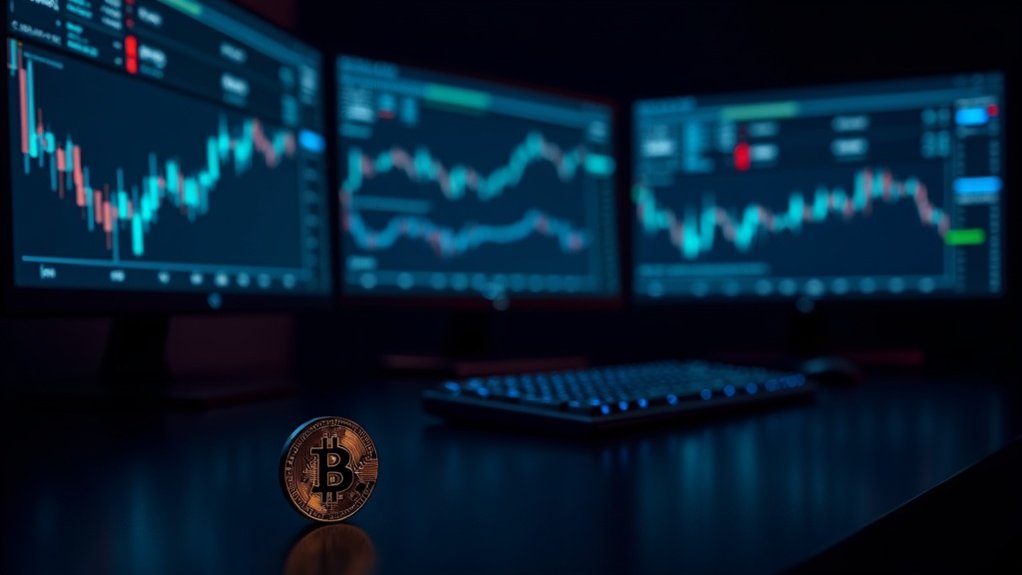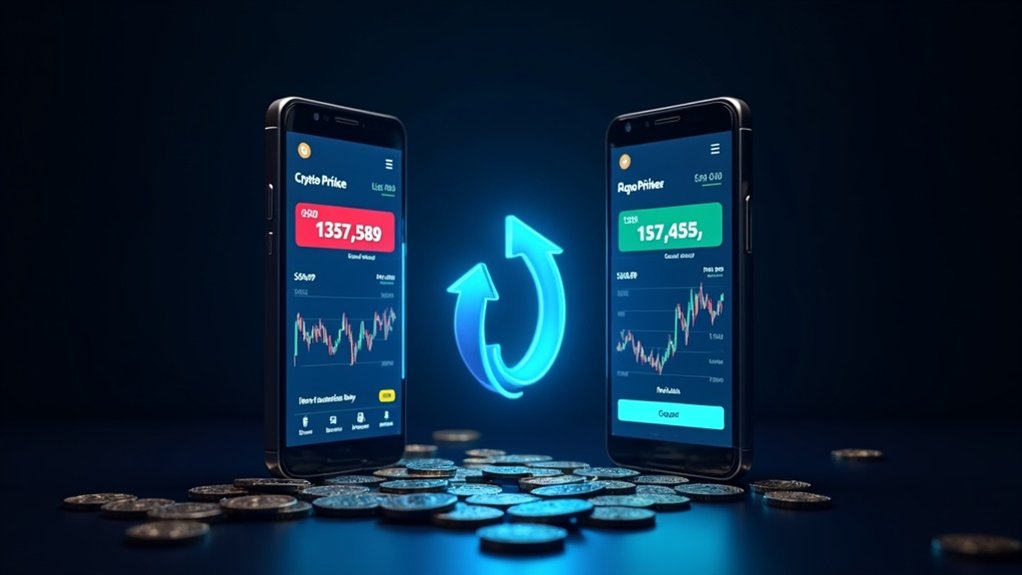Cryptocurrency traders in 2025 face diverse options. Coinbase offers 235 coins with steep 3.99% fees, while Kraken supports 350+ tokens at more reasonable 0.4% rates. Binance dominates volume despite regulatory troubles. All major US exchanges require KYC, unlike decentralized alternatives like Uniswap. Hardware wallets (Ledger, Trezor) provide secure storage away from exchanges. Daily trading volume exceeds $144 billion industry-wide. The crypto landscape continues evolving between regulation and innovation.
Where exactly should crypto enthusiasts park their digital assets in 2025?
The crypto exchange landscape has evolved dramatically, with major players battling for market dominance.
Order book matching ensures efficient trading on centralized platforms.
Coinbase stands out with support for 235 cryptocurrencies, though fees can climb to a wallet-pinching 3.99%.
Not exactly budget-friendly.
Meanwhile, Kraken offers a more impressive 350+ tokens with substantially lower fees maxing at 0.4%.
When it comes to token selection, Kraken dominates with 350+ cryptocurrencies while keeping fees at a wallet-friendly 0.4% max.
Do the math.
Binance US might list fewer coins at 158, but their competitive fee structure tops out at just 0.6%.
They’ve had their share of drama though.
The parent company’s Cayman Islands platform coughed up a staggering $4 billion settlement with US regulators in 2023.
Ouch.
New management, same massive trading volumes.
Speaking of volume, Binance continues crushing competitors globally, with daily trading activity several times higher than rivals like Bybit and OKX.
KYC is non-negotiable in 2025.
Every major US exchange—Coinbase, Kraken, Binance US, Gemini, Crypto.com—demands it.
For those concerned about security, hardware wallets like Ledger and Trezor offer password-protected storage options separate from exchanges.
Regulators aren’t playing around anymore.
The crypto Wild West days are dead and buried.
For those allergic to showing ID, decentralized exchanges offer an alternative universe.
DEXs like Uniswap and aggregators like Matcha provide access to millions of tokens across multiple blockchains.
No middleman, no KYC, no problem?
Well, sometimes problems.
Liquidity can be spotty.
Payment methods vary widely.
Want to use PayPal?
Stick with Coinbase or Kraken.
Credit cards work almost everywhere but expect fees.
Lots of fees.
The industry is clearly splitting between heavily-regulated centralized platforms with fiat on-ramps and decentralized alternatives offering greater token variety and privacy.
Hybrid models are emerging too, trying to deliver the best of both worlds.
Total 24-hour trading volume across 211 tracked exchanges hit approximately $144 billion recently, showing a 51% daily change.
Volatile much?
Currently, SuperEx leads the pack with an astounding 121.81 billion dollars in 24-hour trading volume, far outpacing its nearest competitors.
Trust scores vary wildly, with top exchanges maintaining higher BTC reserves.
Follow the liquidity, folks.
That’s where the market speaks truth.
Frequently Asked Questions
How Do I Report Cryptocurrency Trading Gains for Tax Purposes?
Traders must report all crypto transactions on their tax returns. Period.
Starting 2025, Form 1099-DA enters the scene for exchange-reported transactions.
But here’s the kicker – taxpayers still need to track everything themselves.
Wallet-by-wallet accounting is now mandatory. No more universal methods.
Exchanges don’t track cost basis until 2026, so meticulous record-keeping is essential.
The IRS considers crypto property, not currency. Each trade? Taxable event. Simple as that.
Can I Trade Cryptocurrency if I Live in a Restricted Country?
Trading crypto in restricted countries is technically possible, but risky.
People do it anyway.
VPNs mask locations.
P2P platforms connect buyers and sellers directly.
Decentralized exchanges operate without central authority—no one to shut them down.
Some folks use foreign exchanges or crypto derivatives.
But make no mistake—penalties exist.
Fines, criminal charges, asset seizures.
The legal gray zone is shrinking as global regulators coordinate.
Some just relocate to crypto-friendly nations.
Easier than playing cat and mouse.
What Security Measures Protect My Assets on Crypto Exchanges?
Crypto exchanges employ multiple layers of protection.
Two-factor authentication prevents unauthorized access, while SSL encryption secures data transmission.
Asset reserves and insurance schemes cover potential losses from hacks.
AML and CFT regulations add legal safeguards.
Cold storage keeps most funds offline.
Security audits detect vulnerabilities.
Still, no system’s perfect—the 2025 Bybit breach proved that.
Smart exchanges monitor third-party vendors too.
Hackers are persistent, though.
They always find new angles.
How Do Exchange Insurance Policies Work for Cryptocurrency Holdings?
Exchange insurance policies protect crypto holdings through various models. Most cover exchange assets, not individual accounts.
Binance’s SAFU fund uses trading fees to compensate losses. Coinbase has crime insurance for company-level breaches. Cold storage insurance specifically protects offline wallets.
These policies typically handle cyberattacks, theft, and operational disruptions. But here’s the kicker – they usually exclude user errors like lost credentials. Good luck with that password, folks.
What Happens to My Trades During a Crypto Exchange Outage?
During a crypto exchange outage, trades simply stop. Period.
Pending orders remain unfilled, stuck in limbo until systems come back online.
Your capital? Frozen. Can’t touch it.
Trading volumes tank dramatically—Upbit saw a 94% volume collapse during its 20-hour blackout.
Prices often take a hit too, with negative returns reflecting shaken confidence.
And no, many exchanges aren’t legally required to compensate affected traders. Some do anyway. Most just offer an apologetic shrug and move on.








